Measuring the Cultivated Land Use Efficiency of the Main Grain-Producing Areas in China under the Constraints of Carbon Emissions and Agricultural Nonpoint Source Pollution
Abstract
:1. Introduction
1.1. Literature Review
1.2. Critical Missing Aspects
1.3. Aims of the Study
2. Study Area
3. Material and Methods
3.1. EBM Super Efficiency Model
3.2. Directional Distance Function Model and GML Index Model
3.2.1. Construction of Directional Distance Functions
3.2.2. Global Malmquist–Luenberger Index Model
3.3. Selection of Indicators
3.4. Data
4. Results and Analysis
4.1. Spatial and Temporal Characteristics of Cultivated Land Use Efficiency under the Constraints of Carbon Emissions and Nonpoint Source Pollution
4.1.1. Characteristics of Time Series Changes of Cultivated Land Use Efficiency under the Constraint of Carbon Emissions and Nonpoint Source Pollution
4.1.2. Impact of Input–Output Redundancy on the Cultivated Land Use Efficiency.
4.1.3. Spatial Heterogeneity of Cultivated Land Use Efficiency under the Constraint of Carbon Emissions and Nonpoint Source Pollution in the Main Grain-Producing Areas
4.2. Global Malmquist–Luenberger Index
4.3. Absolute Convergence Analysis of Cultivated Land Use Efficiency
4.3.1. Absolute -Convergence Test
4.3.2. Absolute -Convergence Test
5. Discussion and Policy Implications
5.1. Discussion
5.2. Policy Implications
6. Conclusions
Author Contributions
Acknowledgments
Conflicts of Interest
References
- Liu, Y.S.; Qiao, L.Y. Cultivated land protection system and policy innovation under the background of new urbanization in China. Econ. Geogr. 2014, 34, 1–6. [Google Scholar]
- Li, B. Study on the Carbon Emission of Agricultural Land Utilization and Emission-Reducted Policy in China. Ph.D. Thesis, Huazhong Agricultural University, Wuhan, China, 2011. [Google Scholar]
- Li, Y.; Huang, X.J.; Zhen, F. Carbon emission effects of different land use patterns in Jiangsu Province. Chinese. J. Agric. Eng. 2008, 24, 102–107. [Google Scholar]
- Liu, Y.H.; Ye, S.F.; Xu, C.H.; Qiu, L.F.; Yuan, Y.G. Hazards caused by agricultural non-point source pollution on farmland soil environment. China Agric. Inf. 2016, 12, 100–103. [Google Scholar]
- Cheng, B.; Zhang, Z.; Chen, L.; Yuan, Z.H.; Sun, X.R. The Eutrophication of Water in Taihu Lake and the Control of Agricultural Non-Point Source Pollution in Watershed. J. Agro-Environ. Sci. 2005, Z1, 118–124. [Google Scholar]
- Zhang, W.L.; Wu, S.X.; Ji, H.J.; Kolbe, H. Estimation of Agricultural Non-Point Source Pollution in China and the Alleviating Strategies I. Estimation of Agricultural NonPoint Source Pollution in China Early 21 Century. Sci. Agric. Sin. 2004, 37, 1008–1017. [Google Scholar]
- Pang, Y.; Zhang, Q.J.; Ye, Y.G.; Ou, M.H. Quantitative Economic Analysis of China’s Cultivated Land Use Efficiency. Geogr. Geogr. Inf. Sci. 2004, 4, 40–43. [Google Scholar]
- Wang, K.; Zhang, P. The Research on Impact Factors and Characteristic of Cultivated Land Resources Use Efficiency—Take Henan Province, China as a Case Study. IERI Procedia 2013, 5, 2–9. [Google Scholar] [CrossRef]
- Ye, H.; Pu, L.J. Regional Difference and Convergence of Cultivated Land Use Efficiency in China. J. Nat. Resour. 2011, 26, 1467–1474. (In Chinese) [Google Scholar]
- Wang, L.J.; Li, H. Regional differences of arable land use efficiency and its influencing factors in China: Panel data and stochastic frontier production function method based on 281 cities. Geogr. Res. 2014, 33, 1995–2004. [Google Scholar]
- Bonfiglio, A.; Arzeni, A.; Bodini, A. Assessing eco-efficiency of arable farms in rural areas. Agric. Syst. 2017, 151, 114–125. [Google Scholar] [CrossRef]
- Song, X.Q.; Ou, Y.Z.; Li, Y.S.; Li, F.D. Cultivated land use change in China, 1999–2007: Policy development perspectives. J. Geogr. Sci. 2012, 22, 1061–1078. [Google Scholar] [CrossRef]
- Chen, L.; Song, G.; Meadows, M.E.; Zou, C. Spatio-temporal evolution of the early-warning status of cultivated land and its driving factors: A case study of Heilongjiang Province, China. Land Use Policy 2018, 72, 280–292. [Google Scholar] [CrossRef]
- Liang, L.T.; Qu, F.T.; Wang, C.H. Analysis on cultivated land use efficiency based on DEA. Resour. Environ. Yangtze Basin 2008, 2, 242–246. [Google Scholar]
- Yang, C.H.; Wu, L.; Lin, H.L. Analysis of total-factor cultivated land efficiency in China’s agriculture. Agric. Econ. 2010, 5, 231–242. [Google Scholar] [CrossRef]
- Zhang, R.T.; Jiao, H.F. Analysis of the spatial-temporal pattern and mechanism of inter-provincial arable land use efficiency in China. Chin. J. Agric. Eng. 2015, 31, 277–287. [Google Scholar]
- Zhang, X.; Liu, X.H.; Liu, Y. Research on Cultivated Land Use Efficiency and Its Influencing Factors in Gaojia Town Based on DEA. J. Southwest China Normal Univ. 2012, 37, 72–77. [Google Scholar]
- Dai, J.; Peng, W.Y.; Lian, L.; Li, Z.W. Cultivated Land Use Efficiency Based on DEA in Black Soil Region of Northeast China: A Case Study of Nenjiang County. J. Arid Land Resour. 2017, 31, 38–43. [Google Scholar]
- Feng, X.H.; Zhou, B.T.; Chen, H. Analysis of Cultivated Land Use Efficiency Based on DEA Method—A Case Study of Fengdu County, Chongqing. Chin. Agric. Sci. B 2011, 27, 249–253. [Google Scholar]
- Li, X.; Ou, M.H.; Ma, X.L. Study on Effects of Fragmentation on Cultivated Land Use Efficiency Based on Landscape Index—A Case Study of Lixia River Region in Yangzhou City. J. Nat. Resour. 2011, 26, 1758–1767. [Google Scholar]
- Lu, X.H.; Kuang, B.; Li, J. The Regional Differences and Impact Factors of Cultivated Land Use Efficiency under Carbon Emission Constraints. J. Nat. Resour. 2018, 33, 657–668. [Google Scholar]
- Liu, Y.H.; Wu, P. Analysis on the Farmland Utilization Efficiency of China’s Agricultural Total Factor and Its Influencing Factors in the Transitional Period. Financ. Res. 2011, 7, 114–127. [Google Scholar]
- Feng, Y.G.; Peng, Y.; Deng, Z.B.; Wang, J. Spatiotemporal differentiation of China’s arable land use efficiency from the dual perspective of non-point source pollution and carbon emissions. China Popul. Resour. Environ. 2015, 25, 18–25. [Google Scholar]
- Yang, S.; Li, S.P.; Nie, P. Regional Difference and Convergence of Total Factor Productivity of Cultivated Land in Shaanxi Province. Forum Stat. Inf. 2013, 28, 82–88. [Google Scholar]
- Xie, H.; Wang, W.; Yang, Z.; Choi, Y. Measuring the sustainable performance of industrial land utilization in major industrial zones of China. Technol. Forecast. Soc. 2016, 112, 207–219. [Google Scholar] [CrossRef]
- He, Y.; Xie, H.; Fan, Y.; Xie, X. Forested Land Use Efficiency in China: Spatiotemporal Patterns and Influencing Factors from 1999 to 2010. Sustainability 2016, 8, 772. [Google Scholar] [CrossRef]
- Xie, H.; Chen, Q.; Wang, W.; He, Y. Analyzing the green efficiency of arable land use in China. Technol. Forecast. Soc. 2018. [Google Scholar] [CrossRef]
- Yue, L.; Li, W.B. The Cultivated Land Use Efficiency and Its Influence Caused by Environmental Constraints in China: Based on Global Malmquist-Luenberger Index Method. Agric. Econ. Manag. 2017, 6, 25–35. [Google Scholar]
- Du, J.; Wang, R.; Wang, X.H. Environmental Total Factor Productivity and Agricultural Growth: A Two-Stage Analysis Based on DEA-GML Index and Panel Tobit Model. Chin. Rural Econ. 2016, 3, 65–81. [Google Scholar]
- Xie, H.; Wang, W. Spatiotemporal differences and convergence of urban industrial land use efficiency for China’s major economic zones. J. Geogr. Sci. 2015, 25, 1183–1198. [Google Scholar] [CrossRef]
- Li, G.; Zeng, X.; Zhang, L. Study of Agricultural Productivity and Its Convergence across China’s Regions. Rev. Reg. Stud. 2008, 38, 361–379. [Google Scholar]
- Tian, W.M.; Wan, G.H. Technical efficiency and its determinants in China’s grain production. J. Prod. Anal. 2000, 13, 159–174. [Google Scholar] [CrossRef]
- Zhao, C.P. Analysis of Cultivated Land Production Efficiency and Its Influencing Factors in Henan Province. J. Henan Agric. Univ. 2012, 46, 469–472. (In Chinese) [Google Scholar]
- Zhang, W.Y.; Song, G. Characteristics of Cultivated Land Utilization Benefits in Harbin City. Res. Soil Water Conserv. 2009, 16, 79–83. [Google Scholar]
- Zhang, L.X.; Zhu, D.L.; Xie, B.P.; Du, T.; Wang, X. Spatio-Temporal Pattern Evolution and Influencing Factors of Cultivated Land Use Efficiency in Major Grain-producing Areas of China: An Empirical Study Based on 180 Prefectural Cities. Resour. Sci. 2017, 39, 608–619. [Google Scholar]
- Gai, Z.X.; Sun, P.; Zhang, J.Q. Temporal and Spatial Evolution of Cultivated Land Use Efficiency in Main Grain-producing Areas under Environmental Constraints. Econ. Geogr. 2017, 37, 163–171. (In Chinese) [Google Scholar]
- Wang, K.L.; Liu, Y.; Shi, L.J.; Liu, L.; Meng, X.R.; Yang, B.C. Spatio-temporal differentiation and influencing factors of industrial green water resources efficiency in the Yangtze River Economic Belt: Two-stage analysis based on EBM-Tobit model. Resour. Sci. 2017, 39, 1522–1534. [Google Scholar]
- Shi, F.; Shen, K. Urbanization, Industrial Agglomeration and EBM Energy Efficiency. Ind. Econ. Resid. 2012, 6, 10–16, 67. [Google Scholar]
- Tone, K.; Tsutsui, M. An Epsilon-based Measure of Efficiency in DEA-A Third Pole of Technical Efficiency. Eur. J. Oper. Res. 2010, 207, 1554–1563. [Google Scholar] [CrossRef]
- Li, L.B.; Liu, B.L. Efficiency Evaluation and Cause Identification of High-tech Industry in China. Econ. Dev. Trend 2014, 9, 56–65. [Google Scholar]
- Zofio, J.L. Malmquist Productivity Index Decompositions: A Unifying Framework. Appl. Econ. 2007, 39, 2371–2387. [Google Scholar] [CrossRef]
- Gu, L.L.; Guo, Q.H. Research on the Evolution and Development of China’s Grain Production Area. Agric. Econ. 2011, 32, 4–9. [Google Scholar]
- Jiang, L.; Zhu, F.S. Food Production Status and Policy Suggestions in Main Production Areas of China. Agric. Econ. 2015, 36, 17–24. [Google Scholar]
- Jiang, H.P.; Wu, Z.P. The Policy Suggestions on Establishing Grain Transfer Area for Transferring Payment in Main Production Areas. China Dev. Obs. 2009, 12, 24–25. (In Chinese) [Google Scholar]
- Guo, S.M.; Ma, S.; Chen, Y.J. Research on Comparative Advantages and Development Strategies of Main Grain Crops in China’s Main Grain-producing Areas. Chin. Agric. Sci. B 2006, 1, 391–396. [Google Scholar]
- Jiang, H.P.; Cui, K. Construction and Estimation of Agricultural Modernization Index System in Main Grain-producing Areas of China and Assessment of Development Level. Res. Agric. Mod. 2011, 32, 646–651. [Google Scholar]
- Hou, L.J. Construction of Grain Production Areas in China Based on Food Security Protection. Econ. Probl. 2008, 7, 55–57. [Google Scholar]
- Wang, W.; Deng, W.P. The Three-stage Innovation Efficiency of High-tech Industry and Its Influence Factors—Based on EBM Model and Tobit Model. Soft Sci. 2017, 31, 16–20. [Google Scholar]
- Andersen, P.; Petersen, N.C. A procedure for ranking efficient units in data envelopment analysis. Manag. Sci. 1993, 39, 1261–1264. [Google Scholar] [CrossRef]
- Chung, Y.H.; Fare, R.; Grosskopf, S. Productivity and undesirable outputs: A directional distance function approach. J. Environ. Manag. 1997, 51, 229–240. [Google Scholar] [CrossRef]
- Qi, Y.W. Measurement and Decomposition of China’s Total Factor Productivity Growth under Carbon Emission Constraint—Based on SBM Directional Distance Function and GML Index. Ind. Technol. Econ. 2013, 32, 137–146. [Google Scholar]
- Oh, D.H. A Global Malmquist-Luenberger Productivity index. J. Prod. Anal. 2010, 34, 1345–1355. [Google Scholar] [CrossRef]
- Fare, R.; Grosskopf, S.; Norris, M. Productivity Growth, Technical Progress, and Efficiency Change in Industrialized Countries: Reply. Am. Econ. Rev. 1997, 87, 1040–1044. [Google Scholar]
- Hu, H.; Zhang, F. Research on the Utilization and Efficiency Change of Farmland Resources of Chinese Farmers. China Popul. Resour. Environ. 2009, 19, 131–136. [Google Scholar]
- Pan, D. Research on China’s Agricultural Productivity Considering Resource and Environment Factors. Ph.D. Thesis, Nanjing Agricultural University, Nanjing, China, 2012. [Google Scholar]
- Li, B.; Zhang, J.B. Study on carbon effect characteristics and spatial differences based on the changes of agricultural land use patterns in China. Econ. Geogr. 2012, 32, 135–140. [Google Scholar]
- You, H.Y.; Wu, C.F. Carbon emission efficiency analysis and low carbon optimization of intensive agricultural land use. Trans. Chin. Soc. Agric. Eng. 2014, 30, 224–234. [Google Scholar]
- Liang, L.T. Temporal and Spatial Characteristics of Rural Eco-Environment and Its Evolution. Ph.D. Thesis, Nanjing Agricultural University, Nanjing, China, 2009. [Google Scholar]
- Deng, X.Q.; Cui, Y.P.; Xia, M.P.; Liu, S.J.; Li, N.; Zhao, F. Analysis of Cultivated Land Mechanization and Wealthy Labor in Henan Province. Chin. J. Agric. Mech. 2018, 39, 99–102. (In Chinese) [Google Scholar]
- Wei, H.K.; Wang, Y.Q. The Theoretical Basis and Policy Guidance of the Central Government in Supporting the Development of Major Grain Production Areas. New Econ. Dev. 2012, 11, 49–55. [Google Scholar]
- Tu, Z.G. The coordination of environment, resources and industrial growth. Econ. Res. 2008, 2, 93–105. [Google Scholar]
- Chen, F. Study on Threshold Effect of Arable Land Scale Applied in Agricultural Production Technology. Res. Financ. Econ. Issue 2015, 6, 78–86. [Google Scholar]
- Shi, C.Y. Climate change, investment in agricultural water conservancy and analysis of China’s arable land output efficiency. Agric. Technol. Econ. 2015, 11, 62–68. (In Chinese) [Google Scholar]
- “China’s Agricultural Technology Extension System Reform” Research Group. China’s Agricultural Technology Extension: Status Quo, Problems and Solutions. Manag. World 2004, 5, 50–57. (In Chinese) [Google Scholar]
- Zhang, D.W.; Zhu, R.S. On the Innovation of Agricultural Technology Extension System. Sci. Res. Manag. 2006, 3, 141–145. [Google Scholar]
- Lu, X.; Niu, S.D.; Li, Z.B.; Huang, X.J.; Zhong, T.Y. Study on the status quo and trend analysis of intensive land use in China. Trans. Chin. Soc. Agric. Eng. 2015, 31, 212–224. [Google Scholar]
- Wang, J.; Guo, X.D. Scientific Regulation of Sustainable Land Use at County Scale in China. Progr. Geogr. 2002, 3, 216–222. [Google Scholar]
- Yang, Z.H.; Li, P.; Wang, Y.P. Effects of Aging Rural Labor on the Farmers’ Utilization Efficiency of Cultivated Land. Area Res. Dev. 2015, 34, 167–171. [Google Scholar]
- Yu, W.D. Application of new energy in agriculture. Agric. Equip. Technol. 2014, 40, 7–10. (In Chinese) [Google Scholar]
- Xu, Y.G.; Yang, G.Q.; Wen, G.H. Impact of Cultivated Land Fractionation on Cultivated Land Use Efficiency: An Empirical Analysis Based on Farmers with Different Management Scales. Res. Agric. Mod. 2017, 38, 688–695. [Google Scholar]
- Zu, J.; Zhang, H.; Kong, X.B. Fragmentation characteristics and utilization efficiency of cultivated land in hilly areas of Southwest China: A case study of Caohai Village, Guizhou Province. J. China Agric. Univ. 2016, 21, 104–113. [Google Scholar]
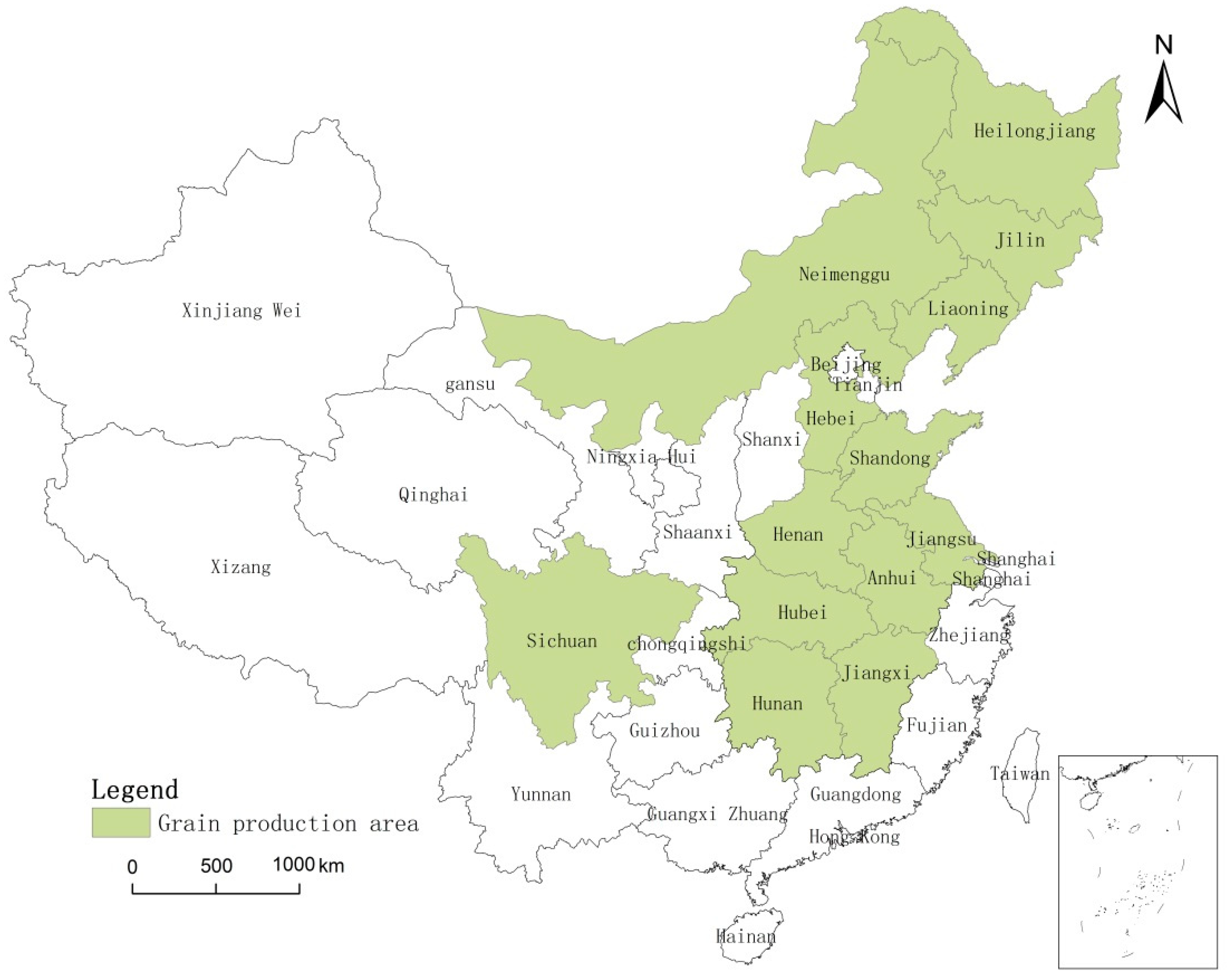
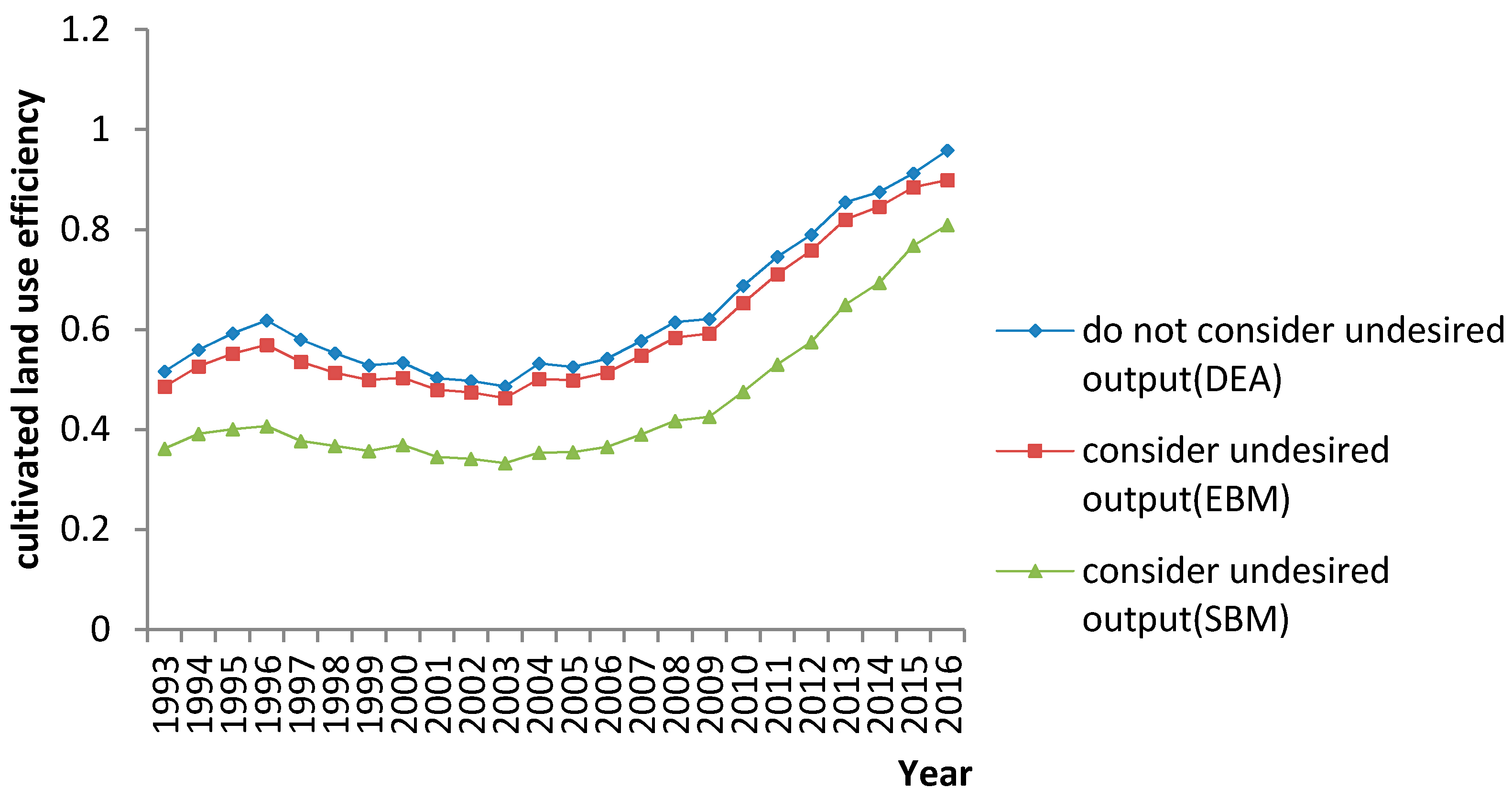
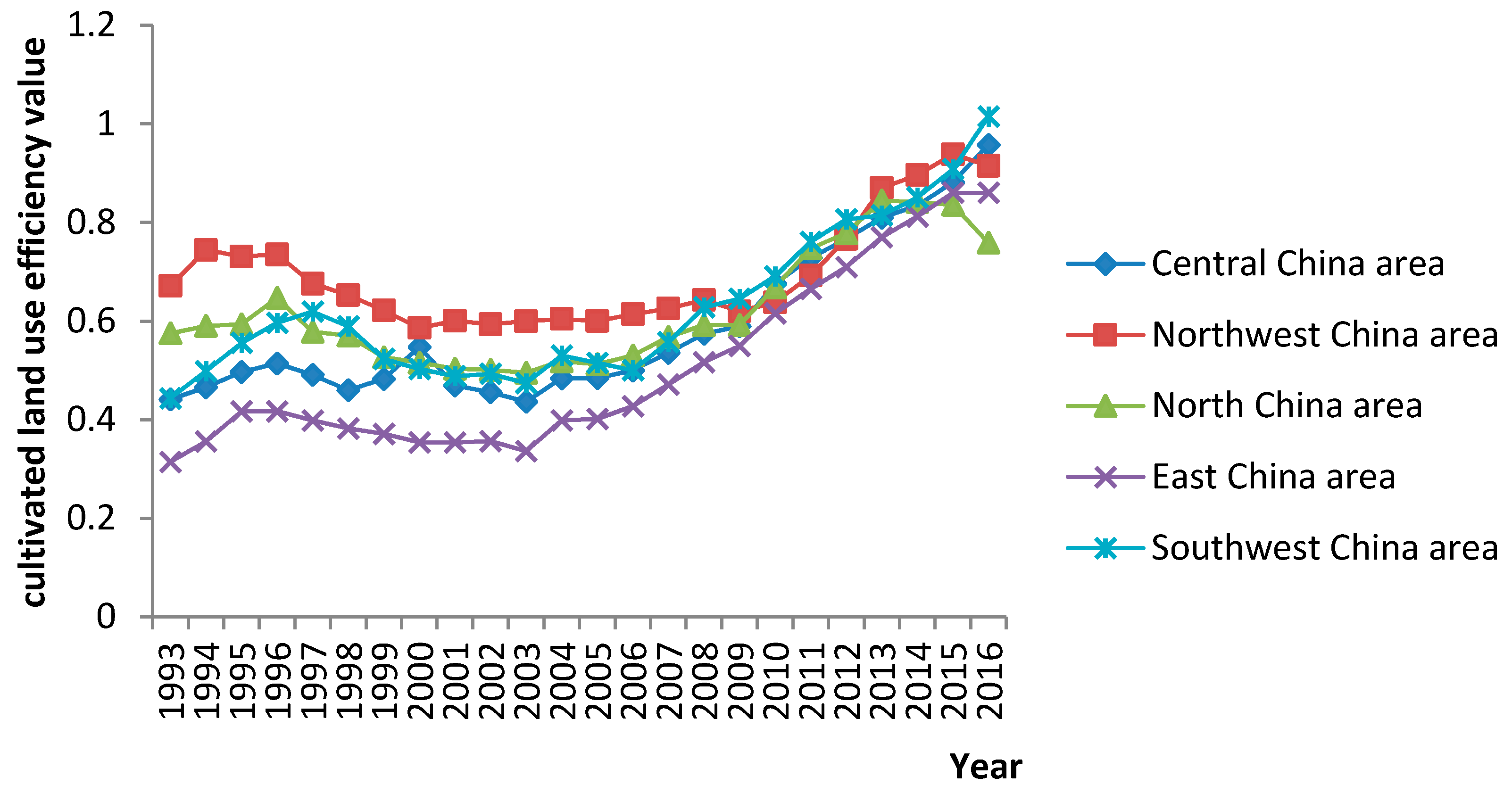

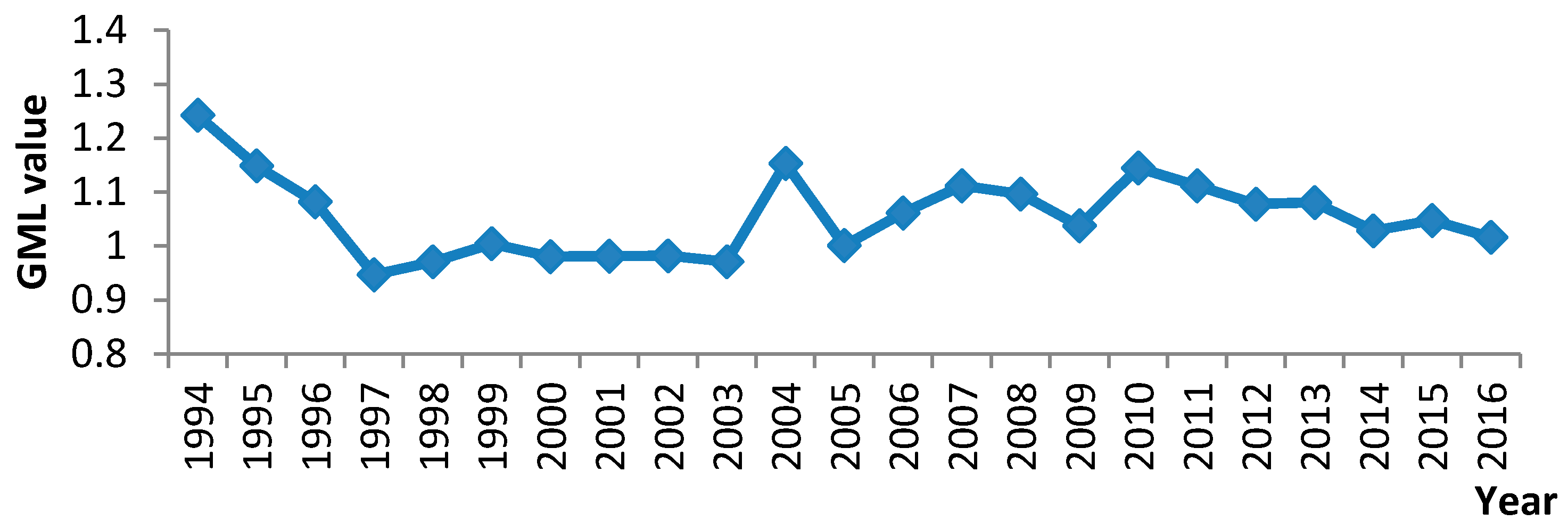


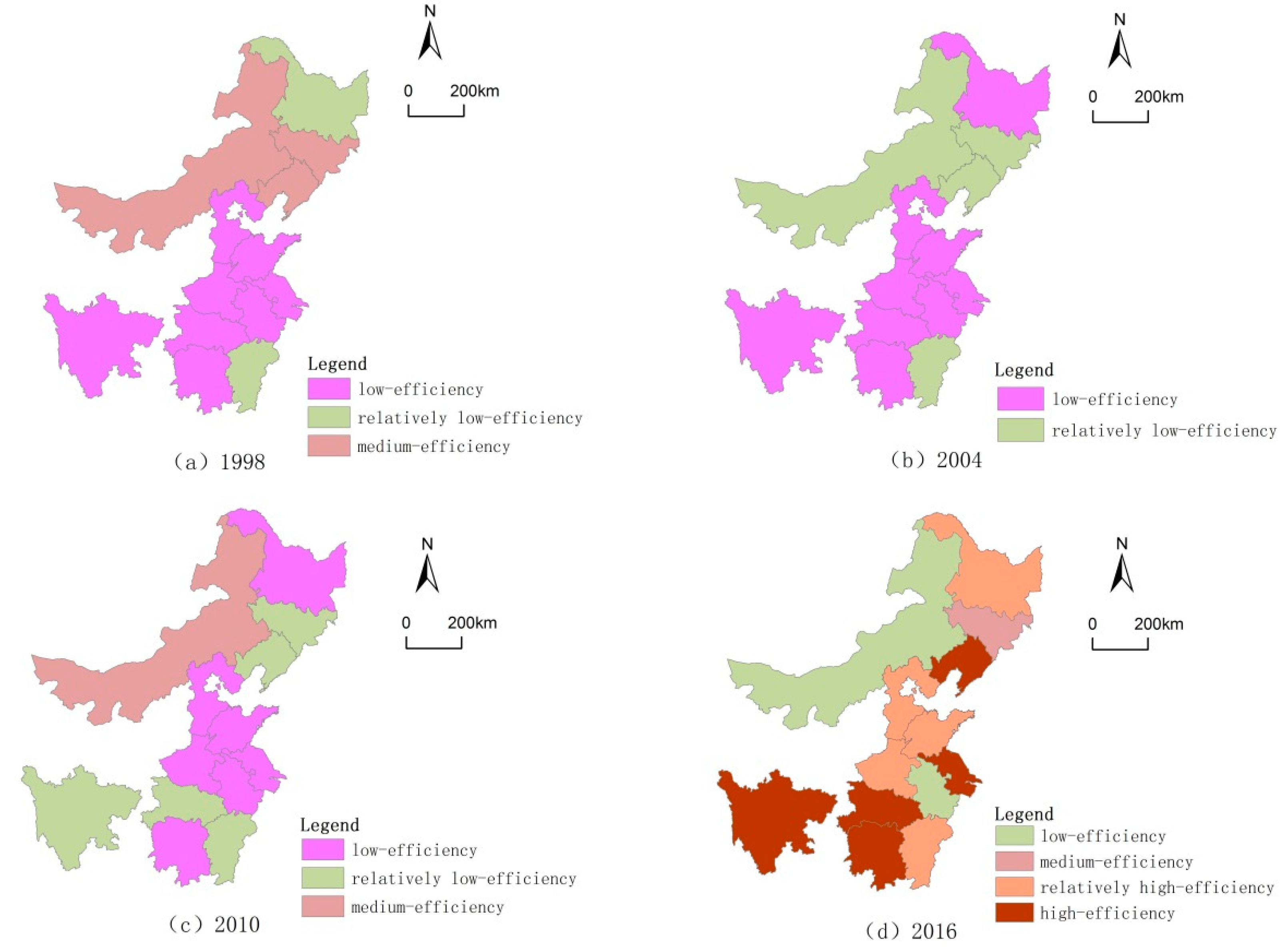
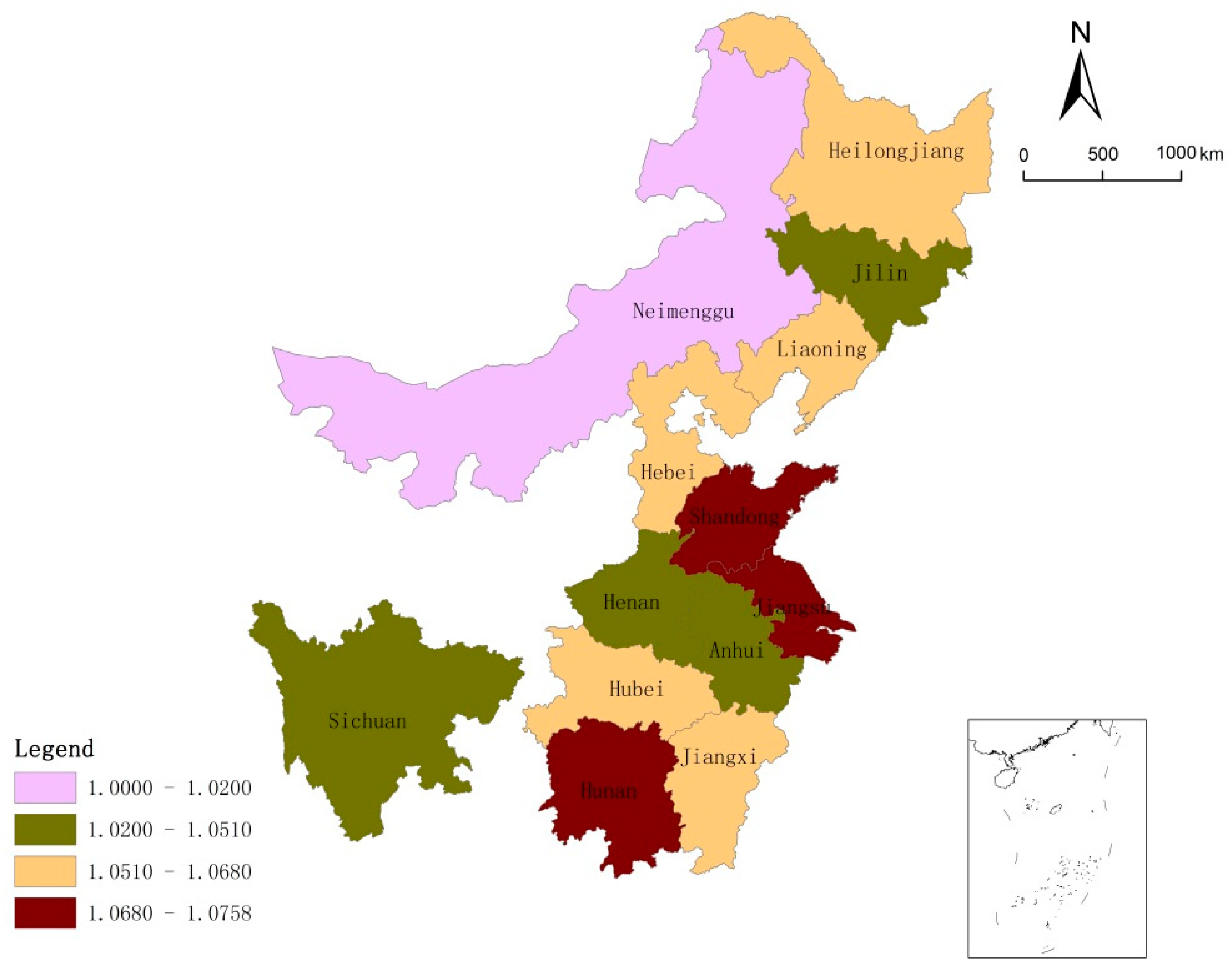

| Abbreviations | Explanation of Abbreviations |
|---|---|
| TFP | Total Factor Productivity |
| EBM | Epsilon-Based Measure |
| ML | Malmquist–Luenberger |
| GML | Global Malmquist–Luenberger |
| GPEC | Global Pure Efficiency Change |
| GSEC | Global Scale Efficiency Change |
| GPTC | Global Pure Technological Change |
| GSTC | Global Scale Technological Change |
| Carbon Source | Carbon Emission Coefficient | Unit |
|---|---|---|
| Pesticide | 4.9341 | kg/kg |
| Fertilizer | 0.8956 | kg/kg |
| Agricultural plastic film | 5.18 | kg/kg |
| Agricultural machinery power | 0.18 | kg/kw |
| Plowing | 312.6 | kg/km2 |
| Irrigation | 25 | kg/hm2 |
| Index | Variable | Measurement Method | Unit |
|---|---|---|---|
| Cultivated land | Crop sown area | 104 hm2 | |
| Labor force | First industry practitioners | 104 people | |
| Fertilizer | Fertilizer application quantity for agriculture | 104 t | |
| Input | Pesticide | Pesticide application quantity | 104 t |
| Agricultural machinery | Agricultural machinery power | 104 kw | |
| Plastic film | Agricultural plastic film | 104 t | |
| Irrigation | Effective irrigation area | 104 hm2 | |
| Expected output | Agricultural output value | Agricultural output value | 108 Yuan |
| Undesired output | Carbon emission | Total carbon use of cultivated land | 104 t |
| Nonpoint source pollution | All sources of pollution and other standard emissions | 108 m3 |
| Period | DEA (Do Not Consider Undesired Output) | EBM (Consider Undesired Output) | SBM (Consider Undesired Output) |
|---|---|---|---|
| 1993~1995 | 0.555808 | 0.521188 | 0.384693 |
| 1996~1998 | 0.583367 | 0.539462 | 0.383736 |
| 1999~2001 | 0.521433 | 0.493888 | 0.357065 |
| 2002~2004 | 0.505165 | 0.479300 | 0.342451 |
| 2005~2007 | 0.547756 | 0.520131 | 0.369802 |
| 2008~2010 | 0.641119 | 0.609405 | 0.439369 |
| 2011~2013 | 0.796428 | 0.762922 | 0.584942 |
| 2014~2016 | 0.914881 | 0.876364 | 0.756749 |
| Average | 0.633244 | 0.600333 | 0.452351 |
| Period | I1 (104 hm2) | I2 (104 p) | I3 (104 kw) | I4 (104 hm2) | I5 (104 t) | I6 (104 t) | I7 (104 hm2) |
|---|---|---|---|---|---|---|---|
| 1993~1995 | −372.7 | −1067.1 | −724.3 | −121.6 | −90.0 | −2.5 | −1.8 |
| 1996~1998 | −349.4 | −964.3 | −930.7 | −123.6 | −105.3 | −2.9 | −2.3 |
| 1999~2001 | −351.1 | −1028.2 | −1363.1 | −128.6 | −109.6 | −3.3 | −2.9 |
| 2002~2004 | −347.0 | −983.5 | −1666.4 | −129.7 | −119.3 | −3.7 | −3.5 |
| 2005~2007 | −332.4 | −843.0 | −1838.5 | −115.8 | −121.7 | −3.8 | −3.6 |
| 2008~2010 | −274.4 | −672.2 | −2014.4 | −95.2 | −112.2 | −3.5 | −3.2 |
| 2011~2013 | −187.6 | −422.0 | −1959.5 | −82.4 | −94.8 | −2.6 | −2.7 |
| 2014~2016 | −80.5 | −200.7 | −1454.0 | −68.4 | −73.6 | −1.6 | −1.3 |
| Province | I1 (104 hm2) | I2 (104 p) | I3 (104 kw) | I4 (104 hm2) | I5 (104 t) | I6 (104 t) | I7 (104 hm2) |
|---|---|---|---|---|---|---|---|
| Anhui | −340.6 | −1113.3 | −1592.7 | −156.5 | −143.7 | −3.6 | −2.5 |
| Hebei | −284.2 | −797.8 | −4997.9 | −208.6 | −114.2 | −2.9 | −2.5 |
| Henan | −612.1 | −1960.4 | −3642.1 | −188.5 | −282.4 | −3.8 | −2.8 |
| Heilongjiang | −549.2 | −166.9 | −556.6 | −101.2 | −45.7 | −1.2 | −1.3 |
| Hubei | −207.9 | −726.8 | −345.7 | −46.2 | −125.8 | −5.3 | −1.2 |
| Hunan | −254.2 | −1179.2 | −735.4 | −82.6 | −63.5 | −4.5 | −1.3 |
| Jilin | −83.3 | −85.0 | −266.4 | −26.6 | −59.7 | −0.7 | −0.6 |
| Jiangsu | −191.1 | −649.5 | −666.5 | −143.5 | −132.0 | −2.9 | −1.6 |
| Jiangxi | −136.7 | −320.1 | −698.7 | −60.5 | −32.3 | −2.8 | −0.7 |
| Liaoning | −57.6 | −133.8 | −349.6 | −30.0 | −19.9 | −1.1 | −2.0 |
| Inner Mongolia | −178.4 | −92.8 | −796.7 | −82.7 | −45.2 | −0.2 | −2.0 |
| Shandong | −399.7 | −1422.3 | −4367.6 | −205.3 | −197.6 | −8.4 | −13.5 |
| Sichuan | −435.5 | −1396.3 | −404.5 | −74.0 | −81.5 | −1.4 | -1.9 |
| Period | O1 (108 Y) | O2 (104 t) | O3 (108 m3) |
|---|---|---|---|
| 1993~1995 | 158.0 | −106.4 | −2377.0 |
| 1996~1998 | 207.7 | −124.8 | −2487.3 |
| 1999~2001 | 265.4 | −133.7 | −2291.1 |
| 2002~2004 | 301.1 | −147.6 | −2221.1 |
| 2005~2007 | 351.1 | −150.5 | −1988.7 |
| 2008~2010 | 348.0 | −137.8 | −1488.5 |
| 2011~2013 | 218.6 | −114.1 | −888.8 |
| 2014~2016 | 439.7 | −82.7 | −551.1 |
| Province | O1 (108 Y) | O2 (104 t) | O3 (108 m3) |
|---|---|---|---|
| Anhui | 366.2 | −164.8 | −1607.6 |
| Hebei | 368.7 | −136.7 | −1943.7 |
| Henan | 460.7 | −293.3 | −3436.1 |
| Heilongjiang | 154.9 | −57.7 | −572.5 |
| Hubei | 164.4 | −147.2 | −3300.9 |
| Hunan | 176.9 | −89.2 | −1443.6 |
| Jilin | 84.0 | −61.2 | −421.4 |
| Jiangsu | 279.0 | −145.1 | −4283.2 |
| Jiangxi | 99.7 | −48.0 | −376.5 |
| Liaoning | 109.9 | −34.8 | −517.7 |
| Inner Mongolia | 66.6 | −54.5 | −355.8 |
| Shandong | 554.4 | −295.4 | v3069.6 |
| Sichuan | 191.8 | −93.1 | v1898.1 |
| Province | 1998 | 2004 | 2010 | 2016 | GML | GPEC | GPTC | GSEC | GSTC |
|---|---|---|---|---|---|---|---|---|---|
| Anhui | 0.8865 | 1.2895 | 1.1481 | 1.1182 | 1.0473 | 0.9898 | 1.0477 | 0.9990 | 1.0236 |
| Hebei | 1.0030 | 1.0675 | 1.2777 | 1.0168 | 1.0597 | 1.0055 | 1.0448 | 1.0035 | 1.0169 |
| Henan | 0.9763 | 1.3680 | 1.2091 | 0.9961 | 1.0510 | 1.0024 | 1.0534 | 0.9945 | 1.0190 |
| Heilongjiang | 0.8116 | 1.1577 | 1.0509 | 0.9916 | 1.0680 | 1.0020 | 1.0146 | 0.9999 | 1.0544 |
| Hubei | 0.9369 | 1.1823 | 1.1816 | 1.0877 | 1.0632 | 1.0212 | 1.0407 | 1.0026 | 1.0231 |
| Hunan | 0.9062 | 1.1663 | 1.2449 | 1.0860 | 1.0772 | 1.0422 | 1.0440 | 1.0015 | 1.0264 |
| Jilin | 1.1680 | 1.0329 | 1.0772 | 0.9030 | 1.0423 | 0.9996 | 1.0007 | 0.9790 | 1.0654 |
| Jiangsu | 1.0020 | 1.2499 | 1.1191 | 1.0008 | 1.0570 | 1.0000 | 1.0410 | 0.9999 | 1.0133 |
| Jiangxi | 0.8730 | 1.0532 | 1.0777 | 1.1073 | 1.0634 | 1.0076 | 0.9976 | 0.9853 | 1.0726 |
| Liaoning | 1.1764 | 1.1690 | 1.1978 | 0.9984 | 1.0656 | 1.0036 | 0.9983 | 0.9955 | 1.0690 |
| Inner Mongolia | 0.9930 | 1.1227 | 1.1498 | 0.8489 | 1.0200 | 0.9877 | 1.0002 | 0.9911 | 1.0628 |
| Shandong | 0.9431 | 1.2025 | 1.1325 | 0.9559 | 1.0758 | 1.0051 | 1.0665 | 1.0107 | 1.0093 |
| Sichuan | 0.9530 | 1.1561 | 1.0796 | 1.0974 | 1.0473 | 1.0011 | 1.0327 | 1.0037 | 1.0155 |
| 1993–2000 | 2000–2010 | 2010–2016 | 1993–2016 | |
|---|---|---|---|---|
| −0.016 | 0.035 *** | 0.016 | -0.008 * | |
| (−1.260) | (5.302) | (0.562) | −1.829 | |
| −0.029 | −0.085 *** | −0.068 | −0.045 *** | |
| (−1.974) | (−10.538) | (−1.088) | (−9.291) | |
| 0.195 | 0.902 | 0.015 | 0.877 |
© 2018 by the authors. Licensee MDPI, Basel, Switzerland. This article is an open access article distributed under the terms and conditions of the Creative Commons Attribution (CC BY) license (http://creativecommons.org/licenses/by/4.0/).
Share and Cite
Xie, H.; Zhang, Y.; Choi, Y. Measuring the Cultivated Land Use Efficiency of the Main Grain-Producing Areas in China under the Constraints of Carbon Emissions and Agricultural Nonpoint Source Pollution. Sustainability 2018, 10, 1932. https://doi.org/10.3390/su10061932
Xie H, Zhang Y, Choi Y. Measuring the Cultivated Land Use Efficiency of the Main Grain-Producing Areas in China under the Constraints of Carbon Emissions and Agricultural Nonpoint Source Pollution. Sustainability. 2018; 10(6):1932. https://doi.org/10.3390/su10061932
Chicago/Turabian StyleXie, Hualin, Yanwei Zhang, and Yongrok Choi. 2018. "Measuring the Cultivated Land Use Efficiency of the Main Grain-Producing Areas in China under the Constraints of Carbon Emissions and Agricultural Nonpoint Source Pollution" Sustainability 10, no. 6: 1932. https://doi.org/10.3390/su10061932
APA StyleXie, H., Zhang, Y., & Choi, Y. (2018). Measuring the Cultivated Land Use Efficiency of the Main Grain-Producing Areas in China under the Constraints of Carbon Emissions and Agricultural Nonpoint Source Pollution. Sustainability, 10(6), 1932. https://doi.org/10.3390/su10061932







